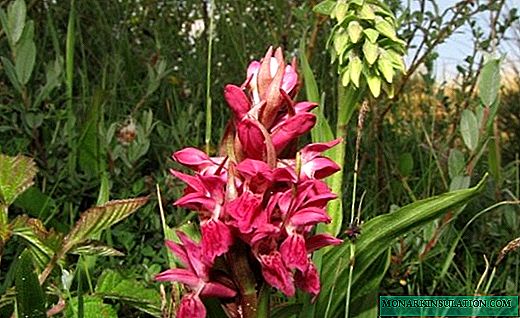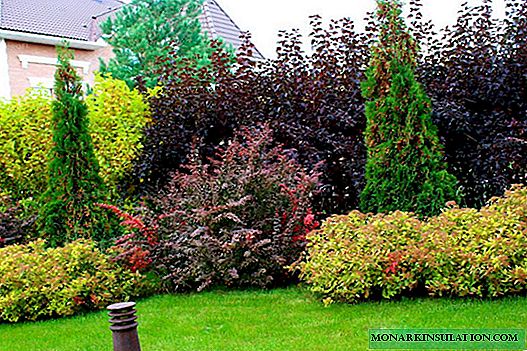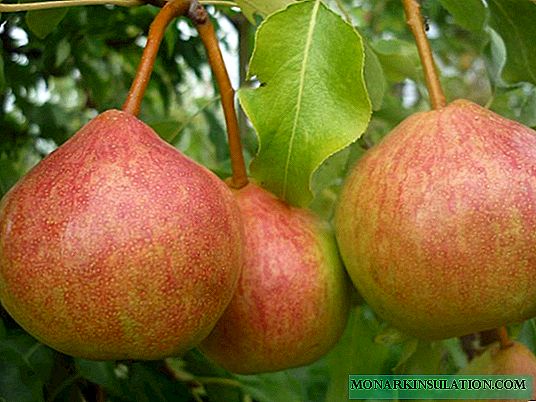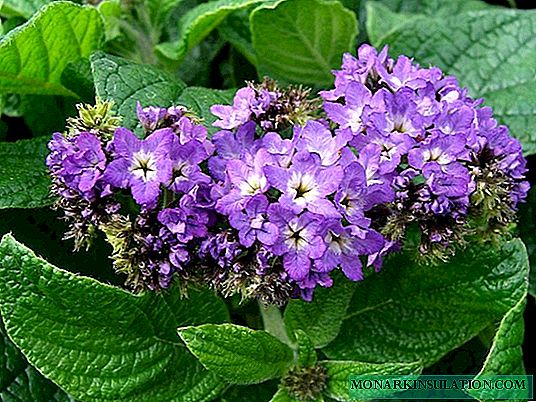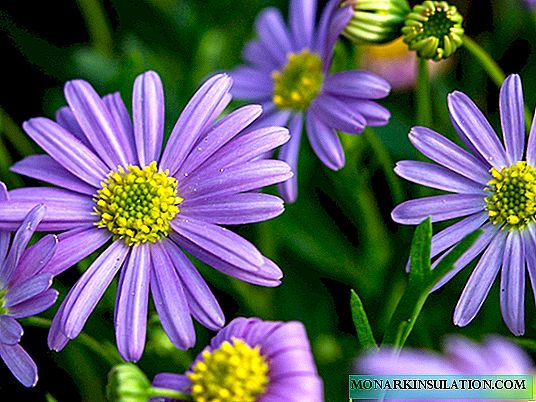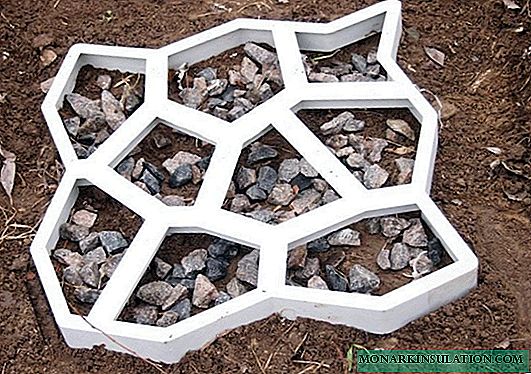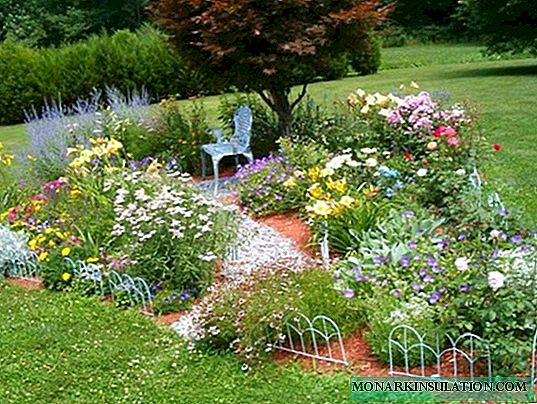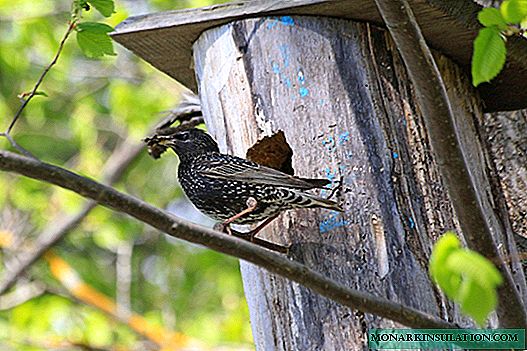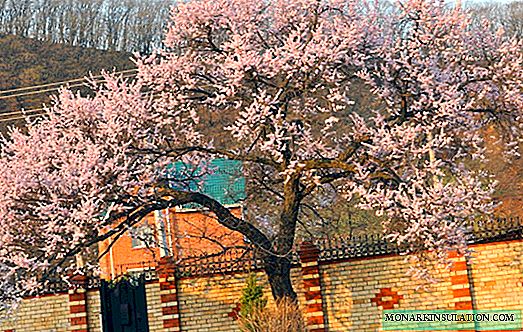
In the wild, apricot can be found not only in the southern regions, but also in Eastern Siberia, Manchuria. These plants became the ancestors of many winter-hardy varieties, which made it possible to grow apricot in a colder climate.
How apricot grows
In good conditions, the apricot grows up to 8 meters in height, but more often these deciduous trees are much lower, only 4-5 meters. The smooth brown bark of young trees cracks over time. Young twigs of red-brown color. Fine-toothed petiole leaves have a rounded shape extended to the apex. White or pale pink flowers of 2-3 centimeters in diameter on short pedicels appear in April or May, when the leaves have not yet blossomed. Fruits are rounded, juicy with a pronounced longitudinal groove. They are of different shades of orange with one large bone inside. Apricots ripen from late June to early September, depending on the variety, soil, planting location and climatic conditions.
Beginning of fruiting
Apricot begins to bear fruit from 3-6 years of life (depending on the variety), if grown from seed. Fruiting lasts 30-40 years.
Cultivation and care
For growing apricots, loamy soil with neutral acidity is suitable with deep occurrence of groundwater. Heavy loams and clay soils contribute to stagnation of moisture, which leads to rotting of the roots and death of seedlings.
Where to plant
The place for the tree should be chosen sunny, well protected from the northern gusty winds or to protect the apricot with an additional fence. It can be a hedge or several deciduous trees that will not obscure the seedling. Planting is best done in the spring, the seedling will have time to take root well. In autumn, the weather can change suddenly and the tree does not have enough time to develop the root system.
Although we will plant apricot in the spring, preparation should begin in the fall. Dig a hole 80 cm deep and wide. Drive a peg of sufficient length to the bottom in the center so that it protrudes 60-80 centimeters above the ground. If the soil is quite heavy to cause stagnation of water, then crushed stone is poured onto the bottom of the pit with a layer of 15-20 cm. Peat or humus must be added to the soil that has been removed from the pit (2 volumes of soil - 1 volume of peat), 0.5 kilograms of superphosphate and 2 kg of ash. Mix well and return this mixture to the pit.
In spring, dig a hole in the settled ground according to the size of the roots of the seedling. Check for dried or rotten roots. They need to be deleted. Prepared roots are lowered into a mash of clay and mullein. The seedling should be lowered into the ground so that the root neck is 5-6 cm above the ground. We fill the roots with earth, rammed and watered with two or three buckets of water. When water is absorbed, the earth will sag, and the root neck will be at the level of the surface of the earth. Now we tie the tree to a peg driven in from autumn.
Care
Apricot care is reduced to the traditional weeding of trunks, top dressing, watering and pruning. A feature of caring for this tree is the regular cleaning of leaves around it in the fall. Wet leaves in the near-stem circle can cause the bark to ripen, which will lead to the death of the tree.
Top dressing
In spring, you need to feed the tree with nitrogen fertilizers. Do this before and after flowering, fertilizing the soil. It is better to feed trees with liquid fertilizer. On the crown perimeter, dig a groove 15 centimeters deep for half a spade and pour a solution of a tablespoon of nitrogen fertilizer into a bucket (10 liters) of water.
Such top dressing is rather laborious. It can be replaced by spraying apricot with urea (urea) with copper sulfate. Dissolve 700 grams of urea and 50 grams of copper sulphate in a bucket of water. This solution has three functions: it feeds the tree with nitrogen, protects against pests and delays flowering for two to three weeks, which is very important for apricot, as it allows it to avoid late frosts. The trunk circle also needs to be sprayed with this solution.
The second time they are fed nitrogen fertilizer in June after the excess ovary has fallen.

Apricot branch with ovary
In summer, foliar top dressing is performed. Apricot is sprayed with solutions containing nitrogen and trace elements. After harvesting, a three percent urea solution is treated. In the autumn, organic fertilizers are applied every year: manure, compost or peat. But there is another opinion of gardeners. Such organic fertilizers must be applied every 3-5 years.
Excess nutrients in the soil reduce fruiting. The tree intensively grows the crown to the detriment of the fruit.
Pruning
Apricot pruning begins in the first year of life.
Cropping can be:
- Formative;
- Regulatory;
- Anti-aging;
- Restorative;
- Sanitary.
Forming and regulating trimming are performed simultaneously. Both are aimed at the emergence of new fruiting branches, and the tree was not overloaded with fruits. Regulatory pruning is carried out taking into account the requirements for crown formation.

Forming and regulating pruning is aimed at the emergence of new fruiting branches, and the tree was not overloaded with fruits
The crown can be formed in two ways: sparse-tier and flattening of the crown.
Flattening of the crown - the tree is left without a conductor, that is, the trunk is cut immediately above the skeletal branches and does not allow a single branch to replace it. Branches grow only to the sides.
Sparse-tier - grow 2-3 branches of the first order with a distance up the trunk 30-35 cm between them. Branches located 1 m from the ground are cut in half. All located above the skeletal branches are cut without hemp. The trunk is shortened, leaving 20-25 cm above the main branches. In summer, all branches are cut, growing at an acute angle to the main one. Next year, a second row of branches is formed 35-40 cm from the first. Annual branches 60 cm long are shortened by half, small ones do not touch at all. The trunk (in the literature - the main conductor) is cut off over the last branch of the second row. Subsequently, branches growing inside the crown and thickening it are cut.
Anti-aging pruning is carried out in the spring or in the first decade of August, when new shoots cannot form on the tree. Slices before the end of the growing season have time to overgrow.
Anti-Aging Trimming - video
Recovery pruning is performed on mechanically damaged or frozen trees. Sanitary pruning - removal of dried and diseased branches.
Graft
To improve the quality of fruits and winter hardiness of apricot, vaccinations are used. They start by growing seedlings from the seeds of zoned apricot. In the second year it will already be possible to plant a twig from the fruiting tree and after 2-3 years to get a crop. Such trees are much more resistant to adverse weather conditions.
Apricot can be grafted not only on apricot, but also on other stone fruits: plum, cherry, cherry plum, peach and turn. It is very difficult for beginning gardeners to get a good result from this operation. For this we need:
- good correctly sharpened tools;
- skill of fast and precise movements;
- cuttings prepared in advance;
- knowledge of the most effective way of vaccination to achieve the goal;
- selection of the optimal time for vaccination.
For apricots, spring vaccinations are preferable, when the active movement of juices begins and the danger of night frosts has passed. There are not so many ways to vaccinate:
- regular copying;
Copulation is used if you want to get varietal apricot. Varietal cuttings are inoculated on a seedling grown from seed.

Vaccination of varietal apricot cuttings on seedlings grown from seed by capulation
Actions that are taken while vaccinating by capillary method:
- the seedling to be vaccinated is cut at an angle of 45 °;
- cuttings cut at the same angle;
- apply the cuttings to the seedling;
- achieve complete coincidence of slices;
- fix the stalk on the seedling with a band-aid, electrical tape or cotton cloth.
The main condition for successful vaccination is that the diameters of the stock and scion should coincide up to 1 mm.

Combining cuts of stock and scion is the most important part of vaccination with copulation
A stock is a tree on which it is planted.
Priva - a stalk which is grafted.
- improved copulation

For improved copying, make a double cut on the stock and scion
- in lateral incision;

When vaccinated in a lateral graft, the graft is cut from two sides, and a graft is made on the rootstock, into which the stalk is inserted
- in the cleavage;

Vaccination in the split - the rootstock is split in the middle, long cuts on both sides are made on the root, and the stalk is inserted into the split
- over the bark.

Apricot grafting - cut the bark on the rootstock and insert a stalk, on which the bark is cut from two sides
All this is gained only by practice.
Diseases and Pests
To protect trees from diseases and pests, they need to be sprayed with a solution of 700 g of urea, 50 g of copper sulphate per 10 l of water before kidney swelling. This solution will destroy pests that have overwintered in the bark and spores of most fungi. If this is not done, then you will have to use chemicals throughout the season.
Apricot can be sick:
- moniliosis (gray rot);
- Valsa mushroom;
- bacterial spotting;
- verticillosis;
- cytosporosis (a fungus living under the bark);
- gum-detecting ;;
- kleasterosporiosis (perforated spotting);
- bacterial cancer;
- tape mosaic.
You can determine what your tree got sick by the appearance of the plant.
Moniliosis: the bark is covered with light gray pads, the leaves and branches turn dark brown and fall off, the fruits, not ripening, dry up, burst or rot.

With moniliosis, diseased branches dry with leaves and fruits
In diseased trees, all damaged branches with leaves and fruits are removed. The trunk and skeletal branches are treated with Bordeaux fluid. Places of slices are covered with garden var.
Valsa mushroom: amber-colored ulcers appear on the cortex.

If Valsa is infected with a fungus, ulcers appear on the tree
To cure a tree, it is sprayed with fungicide according to the instructions for the drug.
Bacterial spotting: first you can see dark spots on the leaves three millimeters in diameter. Later, these areas become transparent with a black border. The transparent portion of the cracked edging becomes yellow.

The disease of bacterial spotting appears on the leaves with dark spots
For treatment, the tree is sprayed with copper sulfate according to the instructions for the drug.
Verticillosis: leaves turn yellow on the lower branches, and the upper ones remain green.

Yellowing branches of the lower branches of the apricot - a sign of tree disease verticillosis
Treatment - spray with fungicide according to the instructions for the drug.
Cytosporosis: leaves fade at the top of the crown, brown spots appear on the bark, the disease spreads from top to bottom, affecting the branches and trunk, the tree dies.

Brown spots on apricot bark - a sign of a tree disease with cytosporosis
Fighting the disease - the affected branches need to be cut. In the spring, before the buds swell, the trees are sprayed with a solution of Bordeaux mixture: 300 g of copper sulfate and 300 g of quicklime per 10 l of water.
Cameo-detection: amber or brown, sticky fluid can appear on any part of the tree, including the fruit. After some time, this liquid hardens and hardens.

Amber resin on the trunk or branches of an apricot - the tree fell ill with gum
All damage should be thoroughly cleaned with a sharp garden knife. At the same time, the gum itself and some healthy tissue surrounding it are removed, capturing about 4-5 mm. All cleared places should be covered with garden var.
Kleasterosporiosis: crimson spots appear on the leaves, which after a while fall out, forming holes.

Apricot kleasterosporiosis manifests itself in holes on seemingly healthy leaves
As soon as the affected shoots are found, they are sawn off and burned. The cut places are covered with garden var, these procedures must be carried out before leaf fall.
Bacterial cancer: the bark on the branches or trunk begins to crack, there are sagging and thickening.

Apricot bacterial cancer most often occurs due to frost pits
The main procedure in the fight against bacterial cancer is the trimming of the affected branches, and then the puttying of the cutoff site with garden varnish with the addition of fungicide.
Ribbon mosaic: yellow stripes along the veins are visible on the blossoming leaves. Gradually, these strips grow, the sheet dies. Treated trunks of copper sulfate according to the instructions.

Tape mosaic disease appears on leaves with brown spots and redness
The main pests of apricot trees are only three: codling moth, leaf moth and aphid.
Codling moths are harmed by caterpillars that appear in August. Then the caterpillars pupate and winter in fallen foliage. The next year butterflies will appear and everything will be repeated.

Outside the fetus is visible, only a small speck in the place where the caterpillar penetrated, and inside you can see the caterpillar itself and the result of its activity
Therefore, the most effective protection against this pest will be the cleaning and destruction of fallen leaves.
Caterpillars appear in the leaflet in spring and begin to eat buds and leaves. They winter in fallen leaves and bark. In July, butterflies appear, lay eggs on leaves and shoots. The caterpillars that emerged from them immediately leave for the winter until next spring.

Leaflet for wintering arranges a "house" of folded leaves
If a leaflet is noticed in the fall, then in the spring an insecticide is treated at a temperature of at least 10 ° C.
Aphids are small insects that live on the bottom of leaves and feed on their juice. The leaves on which the aphid has settled are deformed, faded and wilted. The damaged plant lags in growth and fruiting.

The aphid that settled on young shoots and the underside of the fox sucks their juices
When aphids appear on the leaves, they are treated with some kind of bioinsecticide: Actofit, Actofir, Bitoxibacillin, Boverin. Try to process the bottom of the leaves. During fruiting, chemical preparations are not recommended. Their toxic substances are absorbed into the fruit and can harm a person.
How apricot breeds
Apricot is propagated in several ways:
- green cuttings;
- woody cuttings;
- vaccinations on pre-prepared stock;
- air layering;
- root shoots;
- growing seedlings from seed.
Propagation by green cuttings
A green stalk is a part of a branch with leaves cut from a healthy tree. It is better to take cuttings from young plants and not from the top, but from the lateral shoots of this year from well-lit areas of the crown. Volchovye (growing vertically upward) shoots take root worse due to the lack of carbohydrates in them necessary for root formation.

The scheme of actions that are taken with green cuttings
Green cuttings:
- cut branches with a diameter of not more than 8 mm;
- cut from it cuttings with 3-4 leaves;
- shorten the leaves in half or two-thirds;
- planted in a greenhouse.
It is advisable to cut the shoots in the early morning so that the twig tissues are as saturated as possible. It is good to immediately start planting the cuttings, but if they need to be transported, then the shoots must be put back into the water without delay, so that the leaves do not touch its surface.
Store cuttings can be no more than two days.
Cuttings are cut 8-12 cm long (3-4 sheets) with a very sharp knife or razor blade so as not to squeeze the tissue of the twig. The lower section is made oblique below the kidney, and the upper one is a straight line immediately above the kidney.To reduce the evaporation of moisture, the leaves are cut in half, or even one third is left.
Green cuttings can be rooted throughout the summer (from late May to mid-August).
Now there are several drugs that stimulate root formation: Heteroauxin (indolylacetic acid (IAA)), Cornevin (indolylbutyric acid (IMA)), Zircon (a mixture of hydroxycinnamic acids). These drugs are best used in the form of solutions:
- Heteroauxin - from 50 to 200 mg / l of water,
- Kornevin - 1 g / l of water,
- Zircon - 1 ml / l of water.
Cuttings are soaked in a solution so that the leaves do not come into contact with it. The container with the cuttings must be removed in a dark, but not cold place. The temperature should not be lower than 18ºС. Withstand sixteen to twenty hours. Longer soaking can lead to the opposite result - the roots will not form.
To root the cuttings, you can prepare a special bed or a small container. The place for a bed is chosen in partial shade. They dig a groove with a depth of 20 centimeters, fill it with compost for two-thirds, and fill the remaining 5-6 centimeters with sand. Cuttings simply stick into the sand to a depth of 1-2 cm. Humidify the sand and cover with plastic wrap so that it does not touch the plants. To do this, install arcs or supports. The film should open freely on one side, so that the cuttings can be sprayed with water every 3-4 days. When new ones appear in the axils of the leaves, then the mini-greenhouse will need to be regularly ventilated. First, it is opened for 1-2 hours, gradually the airing time is increased, and spraying is reduced. 3-4 weeks before the transplantation of rooted cuttings, the film is removed completely.
If the cuttings remain for the winter they do not dig, then they are covered with dry oak leaves, spruce branches or peat. If the cuttings are rooted in some capacity, then they can be lowered into the cellar without digging. Most often, it is recommended to plant cuttings in the spring for growing, for 2-3 years, and then transplant to a permanent place. But you can immediately plant in a permanent place so as not to injure the roots.
Rooting green cuttings
Apricot propagation by lignified cuttings
Woody cuttings can be harvested during the entire period of rest of the tree - from autumn after leaf fall to spring, when the buds have not yet begun to swell. Better rooted cuttings harvested during leaf fall or immediately after it. The length of the planting material is 25-30 cm, and the thickness is 6-8 millimeters. The upper section is made directly immediately above the kidney, and the lower oblique is not paying attention to where the kidney is.
Cuttings cut in the fall can be immediately planted in the ground, but they can all die due to weather conditions. Therefore, cuttings are most often stored until spring or begin rooting at home.
There are several ways to store woody cuttings:
- just wrap tightly in a plastic bag and place on the bottom shelf of the refrigerator;
- stick them in wet sand and lower them into a frost-free basement;
- dig in a trench 80 cm deep, lined with non-woven material (lutrasil or something like that), cover with cardboard or polystyrene from above and cover with earth.
It is important that the temperature in the storage location does not fall below 0, but does not rise above + 4ºС.

Woody cuttings can be harvested from autumn to early spring until the buds wake up
Preparation of woody cuttings:
- cut a branch;
- divide it into segments with six kidneys;
- bind into bundles and attach a tag;
- stored in wet sand in the cellar.
In the spring, beds or boxes are prepared for rooting cuttings. The soil must be permeable to moisture and air. Peat and sand in equal parts optimally meet this condition. The layer of this soil mixture on the bed or in the box should be such that almost all of the stalk is planted at an angle of 45 °. Two kidneys should remain above the surface, and the third is very close to the surface. The scheme for planting cuttings is in a box of 10 by 10 cm, on a bed - 10 cm between cuttings and from 10 to 40 cm between rows.

Woody cuttings are rooted in the spring in a prepared garden bed or container
Rooting of a stiffened stalk:
- the handle is immersed in soil to the second kidney;
- rooted cuttings cut off a little shoots and roots;
- planted in a permanent place.
One of the most important conditions when the woody cuttings of good rooting - shoots on it should not develop before the roots.
To do this, the lower part of the handle is treated with drugs that stimulate the growth of the root system. And they strictly observe one more condition - the soil should be warmer than air. For this, the garden bed is covered with plastic wrap, after making holes in it for each handle. At home, a box with cuttings is installed in a cool room, and a weak incandescent lamp is placed under it. With this heating, the temperature of the soil covered with a film should not exceed 18-20ºС, and it should be constantly moist, but not wet.
Apricot propagation by air layering
One of the methods of vegetative propagation of apricot is air layering.
In the spring, choose a branch with an increase of this year. The border between the growth of this year and the past is well traced. You need to step back from this border closer to the tree, that is, according to the growth of last year, 10 centimeters and make two circular cuts up to one and a half millimeters deep at a distance equal to one and a half diameter branches. We remove the bark between the incisions. 4 incisions are made along the branch above the place where the bark was removed. We treat all damage with a drug that stimulates root formation.
We put on a plastic bag with a cut bottom. We fix the tape below the place of removing the bark with tape, tape or wire. Pour moist soil or sphagnum into the bag, previously soaked for a day. The soil can be completely different: purchased, a mixture of humus with sand, rotted sawdust with humus and even just the ground from your garden. A layer of soil with a thickness of 1.5-2 cm should cover the branch slightly above the longitudinal incisions. Press the soil to the branch and fix the upper edge of the bag.

To root a stalk without separating it from a branch
Air Rooting:
- cut off the bark;
- put on a plastic bag with a cut bottom;
- fasten from below;
- pour moist soil or sphagnum;
- fasten on top.
Direct rays of the sun will cause a greenhouse effect. The soil in the bag overheats and the branch dies. To prevent this from happening, on top of the package with the earth can be wrapped in white cloth or newspapers in three layers.
In order for the layering to grow vertically, it is tied to an adjacent branch or some kind of support. Care must be taken so that the soil on the branch does not dry out. If the summer is hot, you will have to moisten it several times.
When the roots become visible in the bag, the seedling is separated from the branch and the bag is removed. A sprig with roots can be immediately planted in a permanent place, but it does not have a central root, and those that are are very fragile. It is better to plant such a sapling in a pot and, after falling off the leaves, put it in a cellar or a cool room where the temperature will not rise above 5-7 ° C, but it will not freeze.
In spring, the seedling is planted in a permanent place.
Rooting Air Layers - Video
Apricot propagation by root shoots
Apricot is rarely propagated by root shoots. Overgrowth can be taken only from trees grown from the seed, and it appears if the roots are damaged by rodents, frost or the aboveground part of the apricot has died.
But if a shoot has already appeared, then you need to carefully dig up the earth around it, get to the root from which it went, cut the shoot along with part of the roots and immediately plant it in a permanent place. This is best done in early spring before budding. Over the summer, the tree is well rooted and strengthened. The place of cut on the root must be treated with garden varieties to avoid decay.

The root shoot is separated from the main root with part of the fibrous roots
Apricot seed propagation
Apricot seeds are sown in autumn, after soaking them for a day in water. Bones are placed in a groove 6 centimeters deep at a distance of 10 cm from each other, covered with earth, and sprinkled with humus and grass on top. Shoots will appear in the spring. They need to be protected from birds and rodents. This can be done with simple plastic bottles with a cut bottom. Over the summer, seedlings will grow up and in the fall they can be transplanted to a permanent place. Such trees begin to bear fruit in the fifth year. But the trees grown from stone are practically not sick and are better adapted to local climatic conditions.
Sowing apricot kernels in autumn - video
Watering apricot
Apricot is one of the most drought tolerant garden trees. But if he does not have enough moisture, the apricot grows slowly, grows old quickly, gives few fruits, and they are tasteless. Trees are watered in a near-stem circle, formed during planting and increased every year to the size of the crown, or in a groove dug approximately at the level of half the crown projection.

The soil under the apricot needs to be wetted deeply, so for one watering several times the water is poured into the trunk circle
A good crop can only be obtained by moistening the soil to a depth of 40-60 cm during the entire growing season, that is, from spring to autumn. The first watering is carried out when ovaries appear, so that they do not fall. The second watering - when the fruit ripens. Water is most needed for a tree in late June - early July, when the seeds harden. At the same time, flower buds are laid. In the future, two more waterings are made in August and September. It is clear that such rare watering should be plentiful.

Apricot requires more frequent and plentiful watering in June
But it all depends on the soil on which the garden grows. On sandy and sandy loamy soils it is necessary to water not four times a year, but much more often. On loam - depending on the weather.
Watering an apricot during flowering
Most gardeners, including professionals, argue that it is impossible to water fruit trees and apricots, in particular, during flowering. If there is little moisture in the soil in spring, then the first time the trees are watered before flowering begins, and the second time 15-20 days after its completion.

Blooming apricot looks like a cloud caught on tree branches
How to save apricot from spring frost
Apricot blooms very early, and return frosts often leave everyone without a crop.
There are only a few methods to make a tree bloom late:
- In early June, pinch this year's growth. The tree will begin to grow lateral branches and lay new flower buds on them. They will bloom a week late, that is, the tree will have a second wave of flowering, and the crop will still be.
- In winter, they tamp the snow under an apricot with a layer of 30 cm. Sprinkle it with sawdust and again pour snow. Under the sawdust, the snow will melt much later. The roots will be cold longer, and the tree will leave late from the state of rest. Therefore, it will bloom later.
- In early spring, before the buds open, trees are sprayed with preparations containing auxin. This will delay flowering for ten days.
- Or sprayed with a urea solution. Flowering will move one to two weeks.
- Trees are treated until the kidneys swell with a three percent solution of Bordeaux fluid. In addition to protection against frosts, this treatment will also protect trees from diseases.
- Before flowering, with swollen buds, 600-700 g per 10 l of water are sprayed with a concentrated solution of sodium chloride. This can delay flowering for 7-14 days.
Features of growing apricots in various regions
In Central Russia, apricot trees often freeze due to poorly ripened shoots. To avoid this, starting in August, trees are poured with ash solution: a liter can of ash per 10 liters of water, insist 3 days. This helps to stop the growth of shoots and their rapid maturation. Typically, 5-10 buckets of ash solution help apricots keep up in the short summer and complete preparation for cold weather for leaf fall.
In the suburbs and the Smolensk region, it is advisable to plant apricot on a mound with a diameter of 2 meters and a height of up to 60 cm, even in places where there is no problem of groundwater. Since the vulnerable place of culture during the thaw is the bark near the root neck. With a high landing, the snow near the stub will melt faster, and melt water will flow down the mound.
Apricot seedlings do not take root in the Leningrad Region, but trees can be grown from seedlings cultivated in the Far East and Khakassia: Amur, Serafim, Khabarovsky, Akademik, BAM, Gift to BAM, " Early Amur "Sayan", "Mountain Abakan", "Siberian Baikalov", "East Siberian".
According to gardeners in the Leningrad Region, the main cause of death of apricot trees is damage to the root collar in spring. Therefore, in this region, such a high landing is appropriate as that used in the suburbs.
The main dangers during cultivation are associated (for you) with rooting of the neck of the neck (therefore landing on a knoll is indicated) and early spillage of the fetus. buds (therefore, with spring fluctuations, the chances of harvest are small). I think the forest environment (pine) is not dangerous, on the contrary, it will smooth the climate.
toliam1 St. Petersburg//www.websad.ru/archdis.php?code=183440
Tanyusha, the main problem for the apricot is aging, so it is undesirable to cover the base of the trunk especially. Our apricot should be planted on a plum, and in the crown, then the chances of growing are very high. And, of course, plant in the warmest place in the garden. Of course, an adult tree in bloom is something!
Natalie St. Petersburg//www.websad.ru/archdis.php?code=183440
In Belarus, agricultural practices are no different from those used in central Russia. Gardeners - the practitioners of this camp determined that they apricots of Russian and local selection are taking root well. Recommended apricot varieties of local selection "Znakhodka" and "Spadchyna", and Russian - "Alyosha" and "Minusinsky amber".
In Siberia, including the Omsk region, and in the Urals, including the Chelyabinsk region, grafted apricots grow well. Cuttings of trees of the Khabarovsk, Khakass and Chelyabinsk breeding are grafted onto the seedling of the Manchu apricot. On very wet soils, apricot dies. A place for its cultivation is selected sunny, protected from the wind, and where the groundwater level is not higher than 2.5 meters.
The agricultural technique of apricot cultivation is slightly different from the care of other stone fruits. It can be grown even in regions where the climatic conditions of its growth are initially not suitable for these trees. It is only necessary to take into account the peculiarities of growing apricots in a particular area, strictly adhere to all the rules of working with a plant in this region, make efforts. And the result will not slow down.

